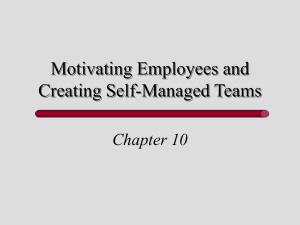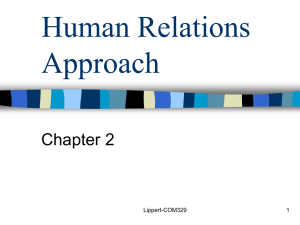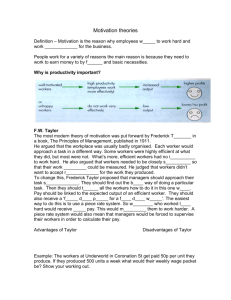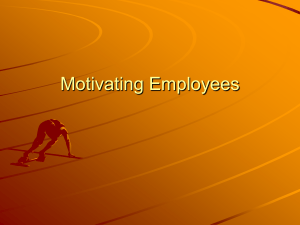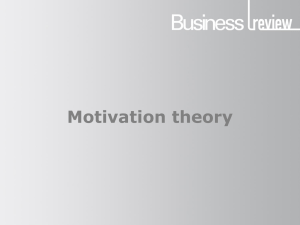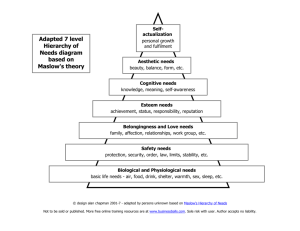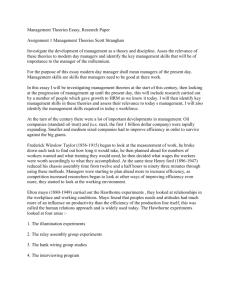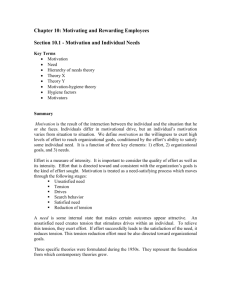Motivating Employees and Creating Self
advertisement
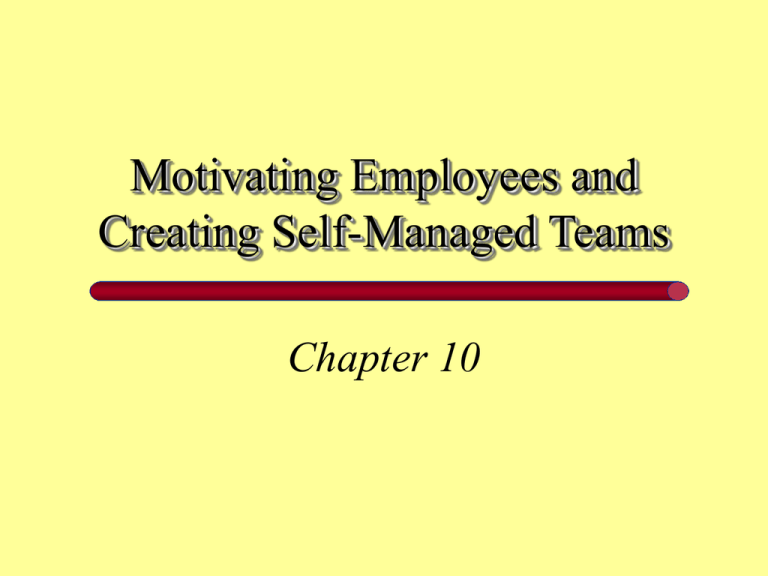
Motivating Employees and Creating Self-Managed Teams Chapter 10 Chapter 10 Learning Goals • • • • • What are the basic principles of Frederick Taylor’s concept of scientific management? What did Elton Mayo’s Hawthorne studies reveal about worker motivation? What is Maslow’s hierarchy of needs, and how do these needs relate to motivation? How are McGregor’s Theories X and Y used to explain worker motivation? What are the basic components of Herzberg’s motivator-hygiene theory? Chapter 10 Learning Goals (cont’d.) • • • • What three contemporary theories on employee motivation offer insights into improving employee performance? How can managers redesign existing jobs to increase employee motivation and performance? What different types of teams are being used in organizations today? What initiatives are organizations using today to motivate and retain employees? Learning Goal 1 • What are the basic principles of Frederick Taylor’s concept of scientific management? – Develop a scientific approach for each element of a person’s job – Scientifically select, train, teach, and develop workers – Encourage cooperation between workers and managers so that each job can be accomplished in a standard, scientifically determined way – Divide work and responsibility between management and workers according to who is better suited to each task Evolution of Motivation Theory 1. Scientific Management 2. Hawthorne Studies 3. Hierarchy of Needs 4. Theories X and Y 5. Motivator-Hygiene Theory Principles of Scientific Management 1. Develop a science of every job element 2. Scientifically select, train, & instruct workers 3. Cooperation between workers & managers 4. Match individuals to well-suited tasks and responsibilities Learning Goal 2 • What did Elton Mayo’s Hawthorne studies reveal about worker motivation? – Increases in performance are tied to a complex set of employee attitudes • Employees singled out for special attention develop pride that motivates workers to increase productivity • Employees will perform better if they feel that management is concerned about their welfare Hawthorne Studies Hawthorne Effect: The phenomenon that employees perform better when they feel singled out for attention or feel that management is concerned about their welfare Learning Goal 3 • What is Maslow’s hierarchy of needs, and how do these needs relate to motivation? – Maslow’s hierarchy of needs consisted of • • • • • Physiological needs Safety needs Social needs Esteem needs Self-actualization needs – Managers can increase employee motivation by modifying organizational and managerial practices to help employees meet all levels of needs Maslow’s Hierarchy of Needs Selfactualization needs Esteem needs Social needs Safety needs Physiological needs Learning Goal 4 • How are McGregor’s Theories X and Y used to explain worker motivation? – Theory X states • People don’t like to work and will avoid it if they can • People must be controlled, directed or threatened to get them to make an effort • Workers want to avoid responsibility but want job security – Theory Y states • Work is as natural as play or rest • People want to be self-directed and will try to accomplish goals in which they believe • Positive incentives will motivate workers • People seek responsibility and are willing to help solve problems – McGregor believed Theory Y assumptions describe most employees McGregor’s Theories of Human Motivation Theory X Theory Y people dislike work work is as natural as play people need to be controlled, & threatened people avoid responsibility & value security people respond to positive incentives people enjoy responsibility & like to solve problems Learning Goal 5 • What are the basic components of Herzberg’s motivatorhygiene theory? – Certain job factors are consistently related to employee job satisfaction (satisfiers) • • • • Achievement and recognition The nature of work itself Responsibility and advancement Growth – Certain job factors can create job dissatisfaction (dissatisfiers) if not well-managed • • • • Company policy Relationships with supervisors, peers, and subordinates Working conditions, salary, and benefits Job security Herzberg’s Motivator-Hygiene Theory Motivating factors: intrinsic job elements that lead to worker satisfaction Hygiene factors: extrinsic elements of the work environment that, if not managed well, lead to worker dissatisfaction Learning Goal 6 • What three contemporary theories on employee motivation offer insights into improving employee performance? – Expectancy theory - motivation depends on link between: • Effort and performance • Performance and outcome • Outcomes and personal needs – Equity theory - based on individuals’ perceptions about how fairly they are treated compared with coworkers – Goal-setting theory - employees are highly motivated to perform when specific goals are established and feedback on progress is offered Contemporary Motivation Theory 1. Expectancy Theory 2. Equity Theory 3. Goal-Setting Theory Expectancy theory: The probability of a behavior depends on: (1) strength of individual’s belief that the behavior will have a particular outcome, and (2) whether the individual values the outcome Equity theory: Worker satisfaction is influenced by employees’ perceptions about how fairly they are treated compared with their coworkers Equity Theory Upward social comparison: comparing oneself to another who is better off on a particular attribute frequently results in decreased satisfaction Downward social comparison: comparing oneself to another who is worse off on a particular attribute frequently results in increased satisfaction Learning Goal 7 • How can managers redesign existing jobs to increase employee motivation and performance? – Job enlargement – horizontal expansion of a job by increasing number and variety of tasks performed – Job enrichment – vertical expansion of a job to provide more autonomy, responsibility, and decision-making authority for employee – Job rotation – shifting of workers from one job to another to broaden an employee’s skill base – Popular motivational tools – Work-scheduling options, employee recognition programs, empowerment, variable-pay programs Applying Motivation Theory 1. Motivational job design – job enlargement – job enrichment – job rotation 2. Work scheduling options – job sharing 3. Recognition, empowerment, & economic incentives – variable pay Job Characteristics Model 1. Skill variety 2. Task identity – task has visible results 3. Task significance 4. Autonomy – employee freedom and independence 5. Task feedback – working on task provides performance feedback Source: Hackman & Oldham, 1976, Organizational Behavior and Human Performance, v. 16, pp. 250-279. Learning Goal 8 • What different types of teams are being used in organizations today? – Problem-solving teams • Employees from same department, area of expertise, and level of hierarchy • Meet to share information and discuss ways to improve processes and procedures in specific functional areas – Self-managed work teams • Highly autonomous groups that manage themselves • Set goals, plan and schedule work activities, select team members, evaluate team performance Learning Goal 8 (cont’d.) • What different types of teams are being used in organizations today? – Cross-functional teams • Employees of same hierarchical level but different functional areas of the organization • Allows people with various areas of expertise to pool resources, develop new ideas, solve problems, coordinate complex projects – Virtual team • Employees from different geographic or organizational locations that use a combination of telecommunications and information technologies to come together • Work together to accomplish a common goal but rarely meet face-toface Group cohesiveness: the degree to which group members want to stay in the group and tend to resist outside influences 2 Types of Cohesiveness 1. Interpersonal cohesiveness: strong bonds & liking between people 2. Task cohesiveness: strong commitment to the group task among members Cohesiveness can increase team performance, but interpersonally cohesive teams may lack task focus Source: Kenrick et al., Social Psychology, p. 441. Pros and Cons of Teams Pros: Cons: • more information & knowledge • can generate more alternatives • often higher-quality decisions • group participation increases acceptance of solutions • take longer to reach solution • members may suppress disagreement • group may be dominated by a few individuals • lack of accountability Types of Teams 1. Problem-solving within one area within one management level 2. Cross-functional within one management level across different areas 3. Self-managed autonomous Building Blocks of High Performance Teams 1. Skills 2. Accountability 3. Commitment • • • • • • Problem solving Technical/functional Interpersonal Small number of members Mutual accountability Individual accountability • Specific goals • Common approach • Meaningful purpose Learning Goal 9 • What initiatives are organizations using today to motivate and retain employees? – Investing more in employee education and training • Makes workers more productive • Less resistant to job change – Managers are offering employees a chance for ownership in the company – Employers are providing work-life benefits to help employees achieve a better balance between work and personal responsibilities • Telecommuting and job sharing • Subsidized child care • On-site fitness centers Trends in Motivation Improved Education & Training Increased Employee Ownership More Work-Life Benefits Deloitte & Touche consulting firm offers Work/life Balance options: reduced hours, reduced workload, continuing parttime, flextime, telecommuting, assistance programs (Source: Deloitte & Touche, www.dttus.com)
